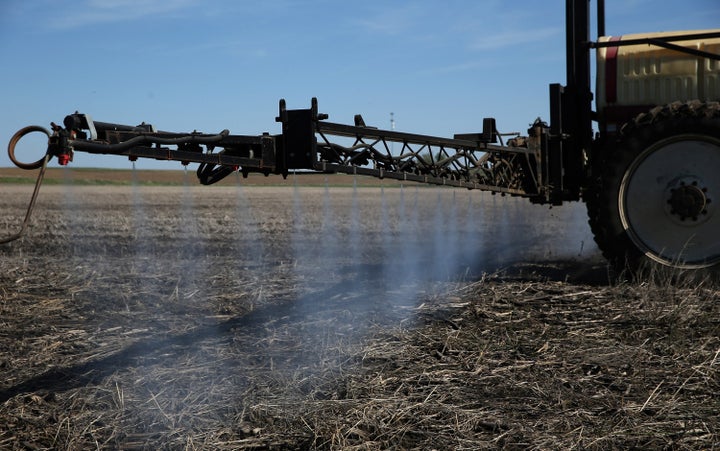
The entire family of widely used pesticides known as organophosphates causes brain damage in children even at low levels of exposure ― and should be phased out.
That’s the finding of a first-of-its-kind paper, published Wednesday in the peer-reviewed journal PLOS Medicine, that examined all the existing scientific literature on a class of chemicals that has for decades served as the main ingredient in farmers’ pest killers.
The results are staggering. The eight researchers who authored the paper found there is no safe level of exposure to any organophosphate pesticide for pregnant women, whose babies suffer disorders ranging from impaired mental and motor skills and memory loss to autism and attention-deficit hyperactivity disorder.
“We’re very concerned that we’re not confident there is any safe level to these chemicals,” Jennifer Sass, a senior scientist at the Natural Resources Defense Council and a co-author, said by phone.

The Trump administration ignited a new debate over chlorpyrifos, one of the pesticides in the family, nearly two years ago when the Environmental Protection Agency abandoned plans to ban the chemical’s use on food. Federal regulators already banned chlorpyrifos from at-home use in 2000. The EPA planned to expand the prohibition to the thousands of American farms that still use the chemical, but then-Administrator Scott Pruitt reversed course, defying the recommendation of agency scientists.
In a letter to Pruitt at the time, the American Academy of Pediatrics, a leading organization of pediatricians, and the Environmental Working Group, a nonprofit advocacy group, said the move “puts all children at risk.”
In August, a federal court ordered the agency to enact the ban, a decision the EPA is appealing.
But the new paper urges national, state and provincial regulators in the 71 countries that use organophosphates to halt that piecemeal approach and phase out all uses of the chemicals at once. The pesticides are frequently used on golf courses, schools, shopping malls and other public spaces. They’re also used in flea and tick medication for dogs and cats, and in insecticides sprayed to kill mosquitoes carrying Zika and West Nile virus. The widespread use has “led to ubiquitous human exposure,” the study said.
“We’re calling for really moving toward a ban on both agricultural and nonagricultural uses,” said Irva Hertz-Picciotto, a co-author and environmental epidemiologist at the University of California, Davis.
The study also calls on medical schools to design curricula around teaching doctors and nurses to identify both acute and chronic effects of exposure and advise pregnant women and parents of young children on how to avoid the chemicals.
Drastically reducing exposure to organophosphates will require major overhauls. The chemicals became popular in the 1960s and 1970s as safer alternatives to DDT, aldrin and dieldrin, widely used insecticides known as organochlorines. By the time the EPA banned DDT in 1972, organophosphates, which naturally degrade much faster than organochlorines, were mainstream.
“The agrochemical industry itself calls it plant medicine, so use it like medicine, use it only with prescription.”
- Jennifer Sass, senior scientist at the Natural Resources Defense Council and study co-author
Alternatives to organophosphates carry their own risks. Pyrethroids, the main class of insecticides now used in residential pest control products, are linked in recent studies to similar developmental issues in children. Neonicotinoids, now the fastest-growing class of insecticides used on crops in the United States, are highly toxic to invertebrates, including endangered species of aquatic life and bees.
Curbing the use of organophosphates likely means adopting low-tech growing methods. That includes crop rotation, physical controls such as traps and vacuums for pests, and intercropping, the process of planting two or more crops in close proximity, which can reduce susceptibility to disease and pests.
“It’s a complicated answer, but the answer has to be moving toward using less and more targeted uses of these agrochemicals,” Sass said. “The agrochemical industry itself calls it plant medicine, so use it like medicine, use it only with prescription.”
The EPA declined to comment on the paper’s proposals.
“EPA has not yet reviewed this study,” Michael Abboud, an agency spokesman, said in an email. “EPA’s priority has always been using the best available science in the most transparent manner to make the best decisions in both the pesticides and toxics programs.”
Adama Agricultural Solutions, the Chinese-owned Israeli chemical manufacturer, said it would review the report “thoroughly to understand the findings and the science behind them.”
“We take all scientifically-based reports by credible sources extremely seriously,” Wayne Rudolph, the company’s executive director of development, said in an email.
The German conglomerate BASF, the world’s largest chemical maker, said it “does not have any organophosphate active ingredients in our product portfolio in the U.S.”
Other big manufacturers of the pesticides ― including Bayer, Sumitomo Chemical, Arysta LifeScience and United Phosphorus Limited ― did not respond to requests for comment.
Chris D’Angelo contributed reporting.
